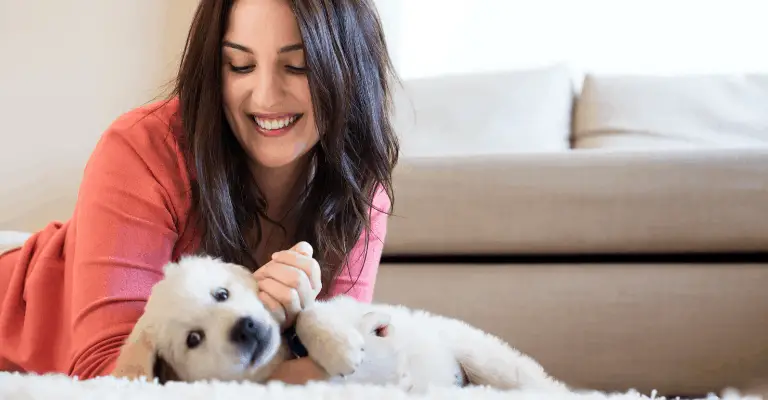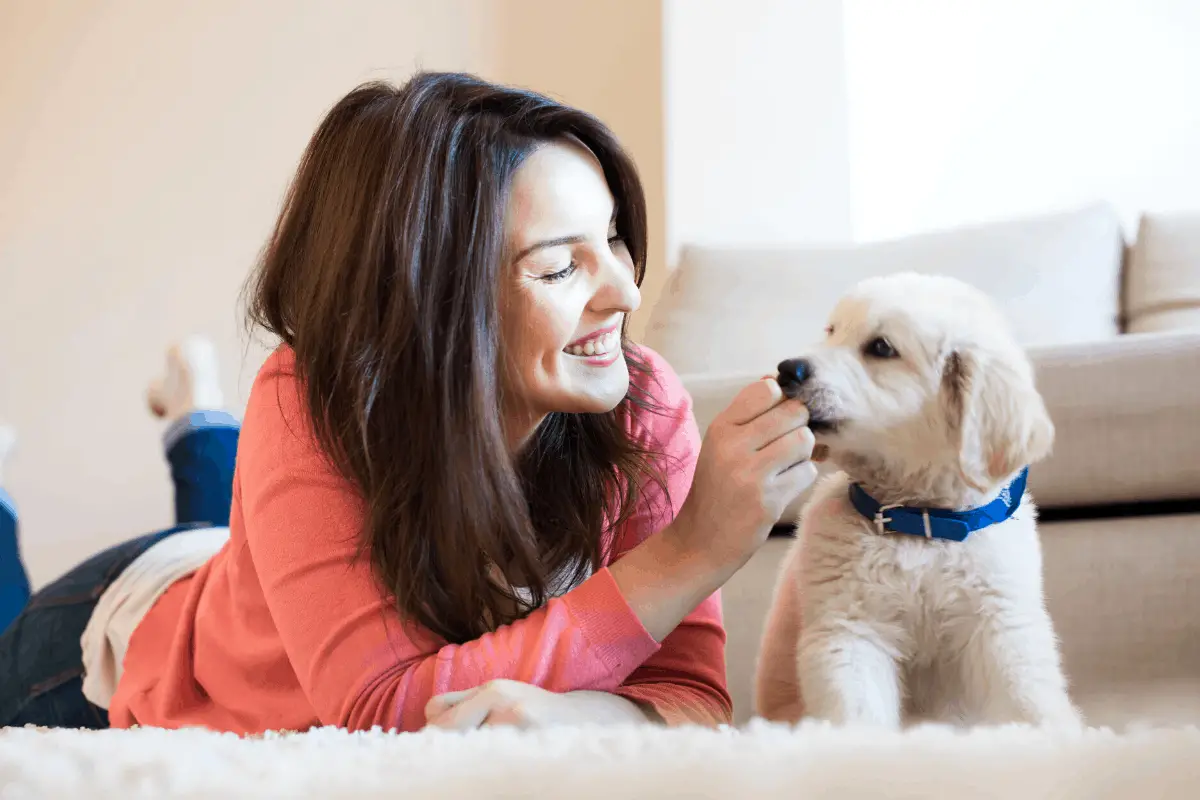Crate training any dog is a challenging job – one that requires patience and persistence above all else. Golden retrievers are a bit of a special challenge, given their high energy levels and need for human attention and interaction.
If you work outside of the home or have a puppy that is progressing in potty training, you may need to introduce more consistent crate training into your day-to-day routine.
Table of Contents
How to Crate Train a Golden Retriever
How do you crate train a Golden Retriever? For effective crate training, follow the guidelines below:
- Prepare the crate
- Introduce your dog to the crate slowly
- Use a verbal command
- Gradually extend the time that they are in the crate
- Keep them crated overnight
- Correct unwanted behavior
Crate training requires a great amount of compassion from you as a dog-owner. You must recognize how uncomfortable of an experience this can be for your dog, and adapt the process as needed to achieve the best results.
Although the guidelines below are general, in the sense that they can be applied to any dog, you must ensure that your dog is comfortable with the training sessions to ensure a safe and positive experience for you both.

1. Prepare the Crate
One of the most important elements of your crate training experience is the crate, of course! You need to ensure that your dog’s crate is not only aesthetically pleasing to you, but comfortable for them!
A Golden Retriever should have a medium-sized crate. Your pup should have room to do all of the following without touching the sides of the crate or contorting themselves:
- Sit up
- Stand
- Turn around
- Lay down
If you have a puppy, you should still invest in a medium-sized crate. This will save you money in the long-run since purchasing a small crate for your puppy’s current size will only be a temporary solution. You’ll have to purchase a larger (more expensive) crate in only a few months, so you might as well get the appropriate size for their adult body now.
Still, a crate that is too large will only encourage your puppy to use one side of it as a rest area and the other for potty purposes, depending on how far along they are in housebreaking training. This will only work against your crate training efforts, so you will need to purchase a crate that “grows” with your puppy.
Some crates come with dividers to expand the floor space of the crate as your puppy grows. Once your pup is fully grown, you can simply remove the divider. These are highly recommended.
Make the Crate a Welcoming Space for Your Pup
When setting up a crate:
- Line the crate with your dog’s favorite bed or blanket
- Toss in some toys.
- Place crate near you
Try not to buy new toys and accessories for this purpose – using things that were already played with by your pup or present in your home is better as they will already have yours and your pup’s scent on them.
Placing the crate near you, makes the crate more comfortable and inviting for your dog. This makes it a positive experience. Place the crate in an area of your home where your dog can still see and hear you. (After all, dogs are social creatures – especially Golden Retrievers! – so you shouldn’t start them off in full isolation or they’ll struggle right away)
2. Slowly Introduce Your Dog to the Crate
Introduce your pup to the crate very slowly. This is imperative to the success of your crate training sessions. Never force them into an unfamiliar crate or other enclosed space – this may introduce (or trigger) trauma and harm the entire process of crate training them.
Allow your dog to have a slow introduction to the crate by using treats or toys. For this, you’ll have to know whether your dog is food-motivated or play-motivated. A few things you can do to encourage them into the crate (and keep them there) include:
- Lots of verbal praise
- Lots of physical praise (i.e., head pats, belly scratches, etc.)
- Using treats or toys to lure them inside of the crate
- Feeding treats through the open crate door to keep them inside
Over time, you must acclimate them to the crate being closed – as you do this, you can feed them treats through the closed door or the wiring of the sides or the top of the crate. This lets them know the crate is a positive area and that there is nothing to fear when inside. You can also feed your dog their regular meals in the crate, to begin to normalize being inside of it.
Continue these slow introduction methods until your dog begins to approach and enter the crate themselves. (Note: Avoid tossing treats into the crate to lure them in. You may accidentally teach them bad habits with this, as it can be difficult to distinguish between a thrown treat and dropped food from your plate, for example.)
3. Integrate a Verbal Command
Once your dog is comfortable with being near and inside the crate, you need to start making this process more intentional. Introduce a command such as “crate” or “place” when you want them to go inside. Do this using similar methods used in Step 2. You’ll want to make sure they are comfortable with going in and out of the crate themselves before you step in with commands.
- As your dog is walking into the crate, tell them your chosen command, and reward them with a treat once they’re inside.
- Once they’ve sat or laid down inside, reinforce the new command with another treat and repeat the word, “crate” or “place.” This will teach your dog that, when they are in their crate, it’s good to sit or lay down.
- Do this a few times in a row per day (no more than 10-15 minutes at a time, depending on your dog’s personality – excessive training sessions will burn both you and your dog out and take away from, rather than contribute to their learning).
If you need more information about training your Golden Retriever, check out our Guide to Training a Golden Retriever.
4. Extend the Time That They Are In the Crate
Now your pup needs to be used to being in the crate for more than just a few seconds at a time. At this point, you’ve already been acclimating them to the crate being closed for brief periods. Now, you need to start extending those periods to more realistically train them for your absence.
Similar to steps 2 and 3, you’ll need to give your dog lots of praise and treats! You’ll need to gently work them up to being in there for several hours at a time:
- Start with just a few minutes.
- Give them their toys and the blankets or bed they are most comfortable with to create a positive atmosphere.
- It may seem silly, but some dogs quite enjoy watching television. If your dog likes hearing or watching TV, leave it on for them on low volume if they will be in a room by themselves. The idea is to make them as comfortable as possible, and the experience of being left alone in the crate normal.
- Start your dog in the crate and stay in the room with them while paying little to no attention to them for several minutes at a time. If they are quiet or otherwise keep to themselves during this time, reward them with lots of praise and treats.
- After they have reached this milestone, you can move onto them being alone in a room for several minutes. With this, you’ll want to start slow, though. Your dog may be used to staying in the crate while you’re in the room, but leaving them by their lonesome is a whole other matter!
The purpose at this stage is to let them know that you will always return, no matter how long you leave them. Start by leaving the room for only a minute at a time. You don’t want to do this excessively, as your dog will start missing the point and it will become more of a game that lasts for a short time. Practice this about twice a day over just about a week for your pup to get the point that you will come back no matter what.
Once they are comfortable with just a minute at a time (after about 1-2 days), make it five minutes, then 10, then 15, and so on. During this phase, it is perfectly normal for your dog to cry and throw tantrums. This is ok, as long as they eventually stop with more practice.
5. Keep Them in the Crate Overnight
You can choose to do this before or after Step 4. The order you do this in depends on the type of dog you have and whether they will respond better to being in the crate with you present or away. As you’re practicing crating for short periods, you can determine whether your dog would benefit from overnight or extended day periods first.
If your dog seems more content with you in the room when left in the crate, they may acclimate better if you trained them with overnight crating rather than leaving for work first. If they are calmer with your absence (you can listen in, either by standing quietly at your door or with a pet monitor), then they will do well with you extending their crate time.
Either way, when crate training overnight, you need to:
- Make sure your dog is comfortable
- Give your pup a safe chew toy
For young puppies, restrict water consumption before they go into the crate overnight. This will prevent them from becoming uncomfortable in the night and/or waking you up early in the morning for a potty break! (For those pups with weak bladders, make sure to line the bottom of their crate with potty pads, just in case!)
Note: When practicing overnight crating, you must stick to a solid schedule. This will help your dog to acclimate, as their body will adjust to the routine. They won’t have to work as hard to fight their bladder (or a hungry tummy!) when they know when they will be released. They also need to know when it’s bedtime.
6. Correct Bad Behavior in the Crate
Lastly, one of the most important things for you to do when crate training is to differentiate bad behavior from acceptable behavior. Things to watch out for are:
- Chewing on the crate. This behavior can seriously harm your dog and cause injuries that can leave their teeth, gums, and nose raw and bloodied. You can curb this behavior by remaining present with them when they are enclosed in the crate so that you can catch the behavior in real-time and correct it as it occurs.
- If this is not an option for you, don’t worry – you are not out of options. Instead, you can purchase bitter apple spray or something similar.
- Pawing at the gate. This behavior is often coupled with chewing, and inevitably turns into your dog pulling at the metal bars. This is also dangerous because their toes can become stuck. Stop this behavior as soon as possible with corrections, and protect your dog’s toes and feet by covering the bottom of the bars – the most likely area for their paws to get stuck. You can make sure this is covered by purchasing a bed with tall sides to block the small gaps between the bottom of the crate and the waste pan.
- Your dog is also less likely to chew on the wiring if you envelop the crate with a cover. This will darken the space and make them feel cozier and more at home. They won’t be able to see through the wiring, rather, straight to the covering fabric, so they’ll have less reason to try and rip through the bars.
- Ripping toys apart. Note that this is only a problem if it wasn’t already normal for your dog. Ripping or otherwise destroying toys is a sign of pent-up energy that can potentially translate into aggression. This must be addressed as soon as possible.
- Possessiveness of the crate/area surrounding the crate. A dog can become overly protective of things that belong to them, including their safe spaces. Although it is a positive thing for your dog to feel comfortable in their crate, it is unacceptable for them to become so possessive that they are aggressive when you or anyone else approaches. No matter how comfortable with their crate your dog becomes, you must be in control of it at all times – the crate does not belong to them, but to you.
- Loud crying, whining, or barking. It is normal for your dog to panic when in the crate, especially if they are new to it. However, you must draw the line somewhere. Dogs are intelligent – if they figure out that crying just for a few hours will get you to let them out, they will continue to do so. You must set clear expectations for your dog while in the crate.
Picking Out a Crate
Picking the best crate for your dog can seem tough. If you are not sure of the best crate to use, be sure to read our article on the Best Dog Crates for Golden Retrievers. We cover the different types of crates, as well as what to look for in one.
The important thing to remember is to get one that is big enough, but not so big they can roam around in it. Getting a crate with a removable divider is important so you can adjust it as your puppy gets larger.
Before Getting Into the Crate

The last thing you want when crate-training your Golden is a pup with too much energy. You want to properly prepare them to go into the crate for both your sake and theirs. Don’t force them into an enclosed space when they’re all worked up! Golden Retrievers need plenty of exercise.
Be sure to exercise them beforehand by:
- Taking them to the dog park
- Going out for a walk or run
- Playing with them for a few minutes before crating (fetch, chase, etc.)
Additionally, when your pup is in the crate, you need to be attentive to their needs. Their bodily functions don’t just stop because they’re sitting still.
Tend to your dog by:
- Making sure they get potty breaks before and after being in the crate.
- Don’t let them go hungry! Make sure they’ve had their breakfast or dinner, or else they’re going to cry, and you won’t know why. It’s not healthy to punish a dog for crying when the reason for their distress is entirely preventable. Make sure you have all your bases covered before crating them.
Conclusion
The difficulty of crate training a dog can vary. Some dogs take to crate training very fast, some take a little longer. Either way you can help make the crate a welcoming safe place for your pup.
Many dogs love going to their crate. Just make sure you do your best at using the crate as a safe spot for your Golden Retriever, and not as punishment.
If you are just purchasing your dog, be sure to check out our recommended products page to see all of our picks for the items you need to raise a healthy Golden Retriever.


